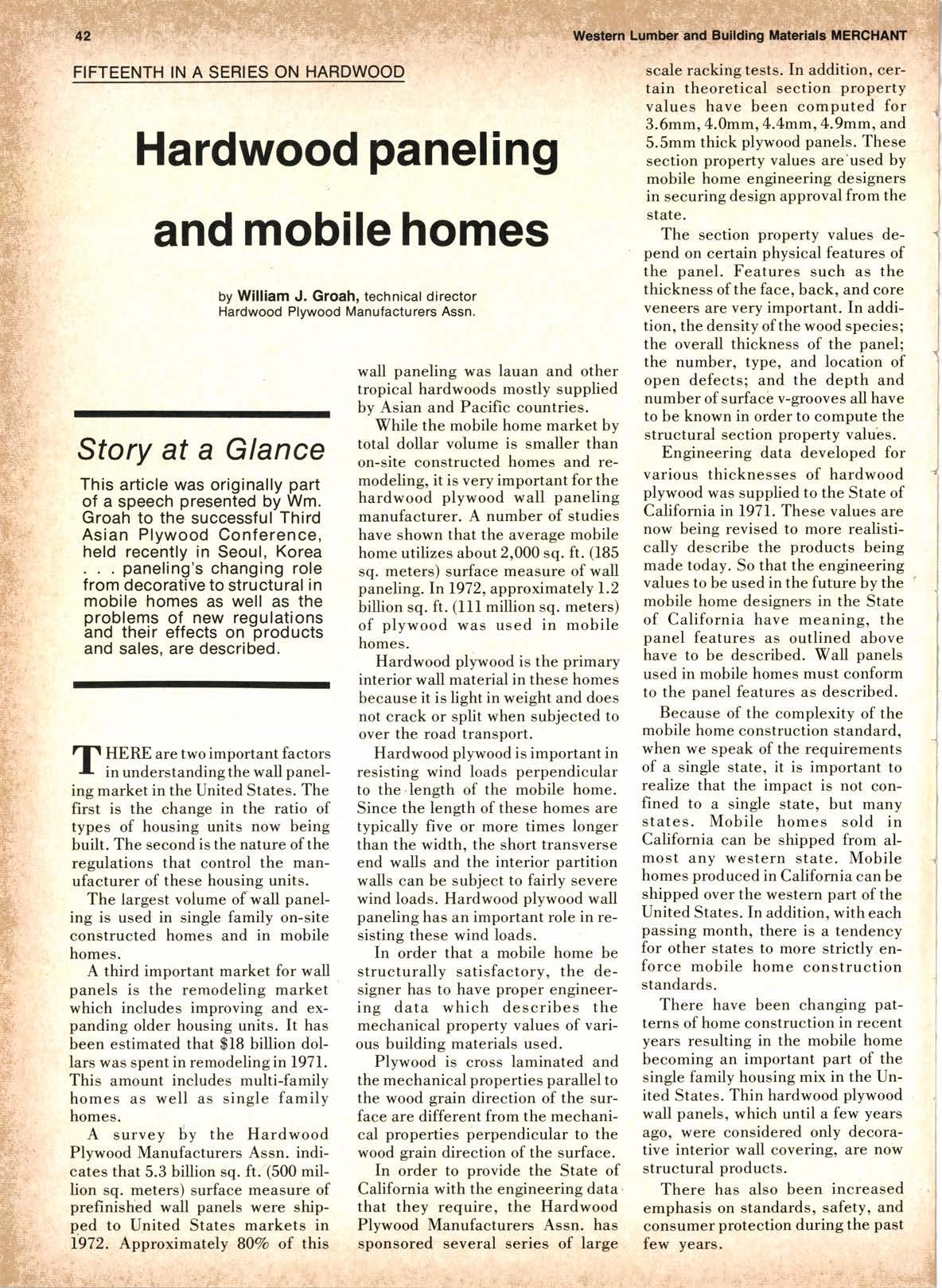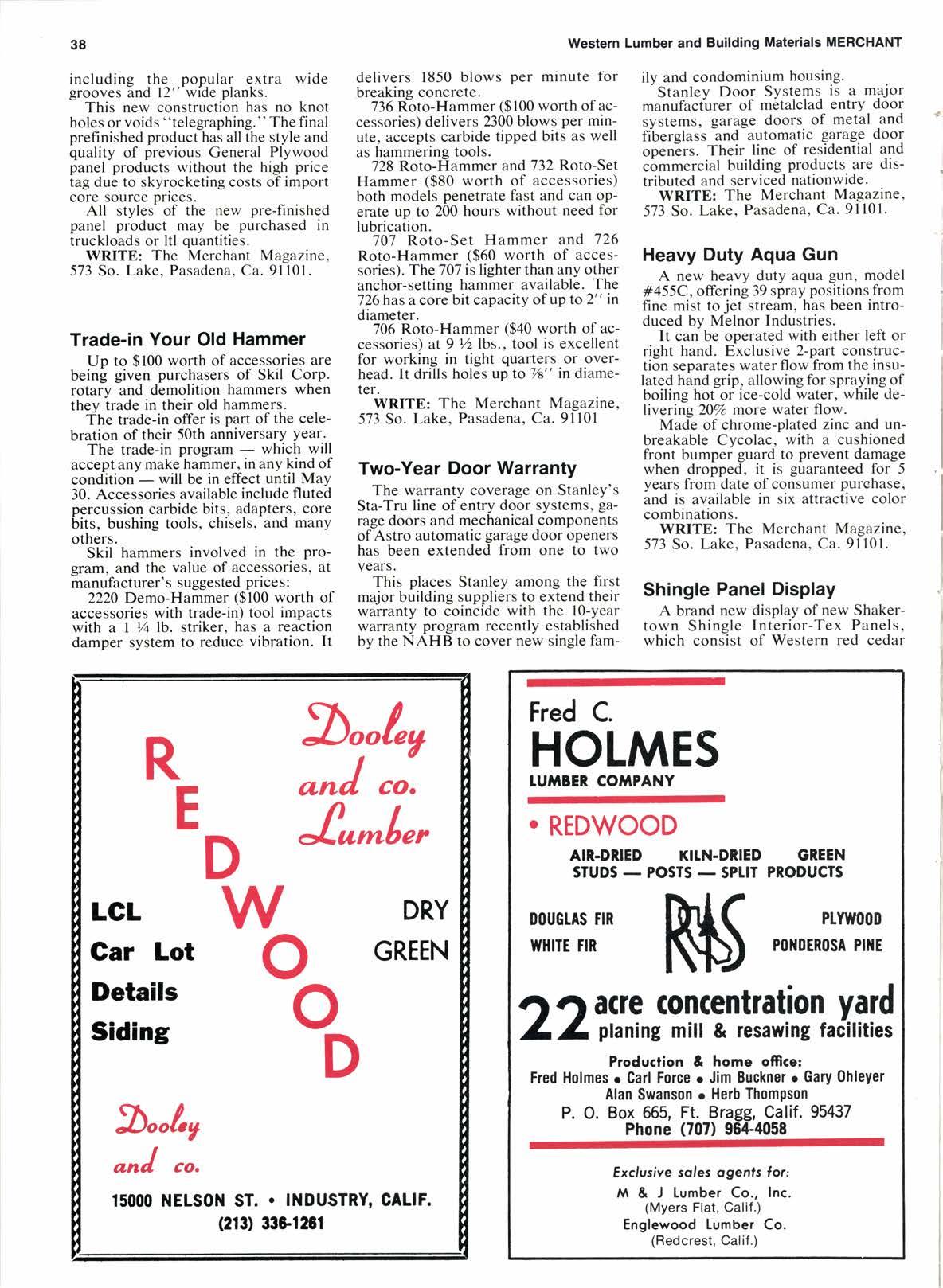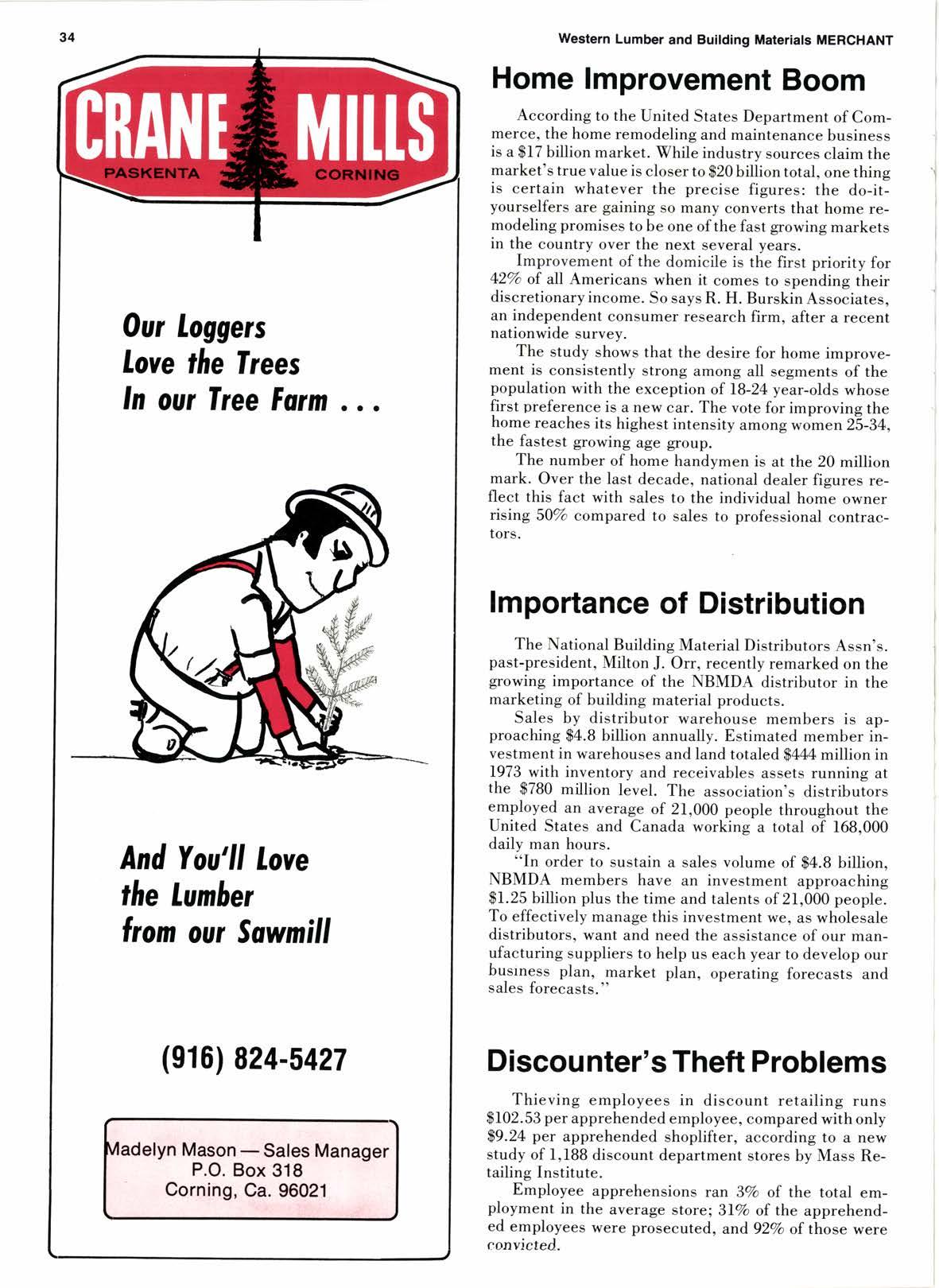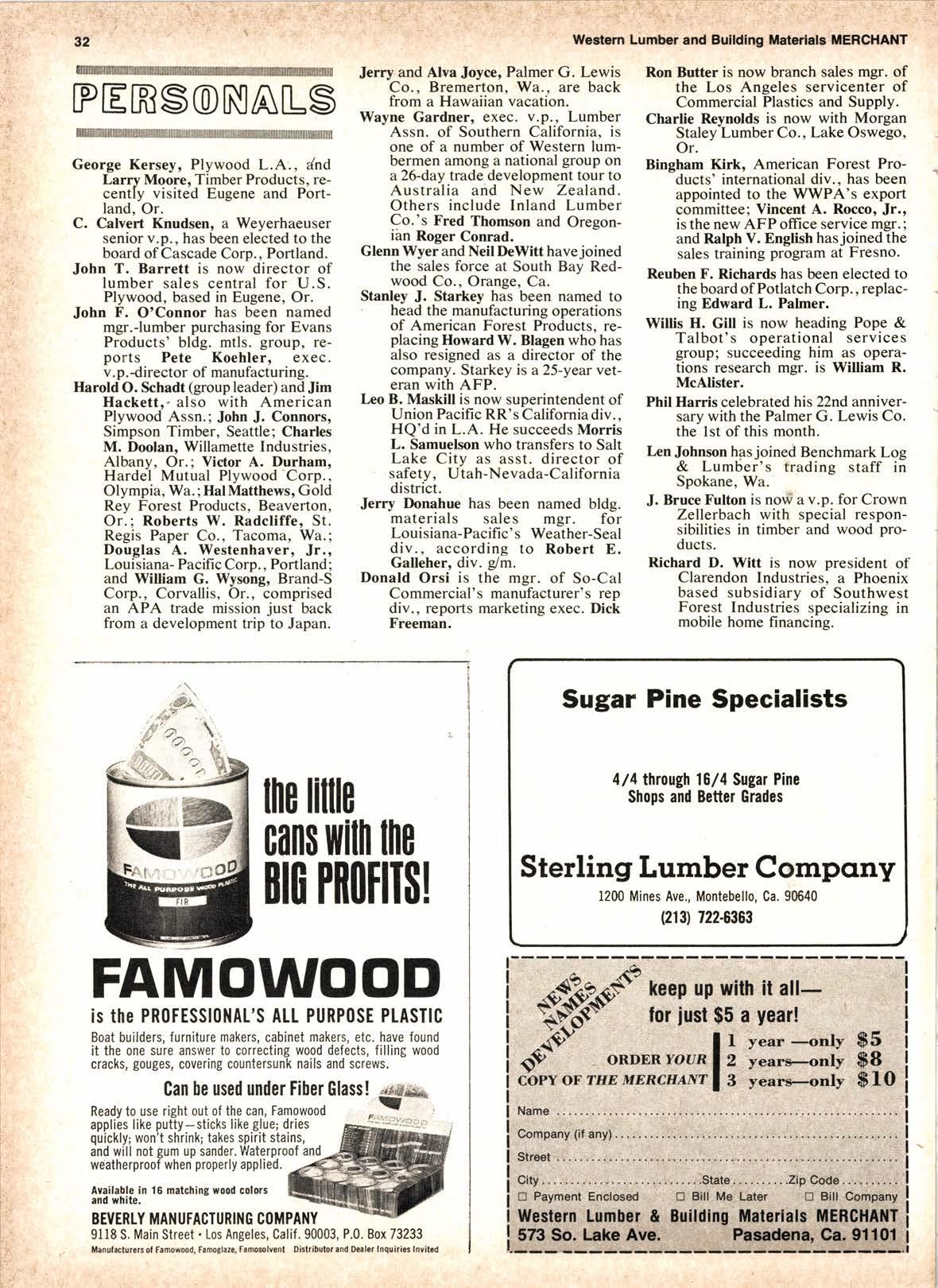
6 minute read
!ndustry rn America's Forest Tomorrow's World
By Gerald Piel * Publisher Scientif ic American Magazine
A NYONE who undertakes to look
A at the future requirements and supplies of essential materials discovers, at once, that wood remains a primary raw material of high civilization.
More people should understand, to begin with, that wood is one of the most abundant materials. It is the world's third commodity. First come the fossil fuels. At this epoch, the world is consuming coal, oil and gas at the rate of 6 billion tons Per annum. Right alongside the fossil fuels come the stone, clay and glass productso meaning principally concrete6 billion tons, again.
Then comes wood, The world is producing wood products at just under 2 billion tons a year. That is nearly twice the tonnage of the food grains consumed by the world population, which runs at just a little more than a billion tons. It is nearly four times the world-wide consumption of steel.
People should know that wood, secondly, is a universal material' Materials science is just now recognizing that wood is, in fact, one of the most sophisticated materials an engineer is privileged to handle, a material that challenges him to realize its values and virtues.
This science now conjures with a whole class of materials called o'composites." They are modeled essentially on the structure of wood. They consist, like wood, of fibers embedded in an amorphous matrix. The fibers in such a material are oriented in the direction in which one \,vants to exploit their strength. Thus, in wood, the cellulose fibers are oriented alongthe grain ofa 2x4.
The plastic material in wood is, of course, lignin. In other comPosite materials, now being made in imitation of wood, the plastic matrix can be any of a number of different kinds of plastic. It can also be a metal, other than the metal of which the fiber is made, or a ceramic. Such exotic materials have been meeting the high stresses and specifications of space enterprises.
*Gerard Piel has been president and publisher of Scientic American magazine since 1947. He usas science editor of LIFE magazine from 1939-19'M. He spent 2 years as a special assistant to Henry J. Kaiser in related industrial aentures. A grad,uate of Harvard, Piel has been the recipient of numerous honorary degrees. This article is excerpted from the speech he gaue at the recent American Forest Institute annual meeting in Portland. See The Mer' chant, Noaember, p. 10. - Editor.
So, suddenly, we realize that we have in woodthe first of the major materials employed by manthe technologically most sophisticated and advanced kind of material.
In the form of sawn wood we use this material as it comes in nature.
We also disassemble and reassemble itstill using the intact composite materialto develop its strength for a particular specifica- 'tion. In plywood, the fibers can be oriented at angles to one another to
Wood can be exploded, as in the Masonite and other reconstructed woods, and the fibers reassembled at random. The empty spaces in wood can be filled with one plastic or another to make the wood alloYs.
From the intact structure of wood we come down a step to seParate the cellulose fibers from lignin in paper technology. New kinds of materials are being developed in the paper industry for engineering purposes, as well as for the wide and essential and diverse uses of paper as such. Alas, we still throw away the lignin.
We come down still another step when we disassemble the fiber down to its constituent cellulose molecules to make the rayons and the other cellulose plastics.
Finally, we disassemble the molecule itself to get wood sugars' wood alcohol, and a whole host of other primary organic chemicals.
Once you have those substances, of course, you have starting materials as diverse and protean as the petroleum and natural gas on which the petro-chemical industry and our plastics industry are otherwise based.
!-inally, compared to all other materials in use in civilization --- and the public needs to understand thiswood is inexhaustible. If we can learn to progress from the hunting and food gathering slate of forest technology"into, at leait, the agricultural phase and learn silviculture, wood can last as long as civilization and can increase with it.
The world today derives its wood from some 3 billion acres of the earth's surface. Some 3 billion acres of forest lands, with which the agricultural era began 10,000 years ago, have disappeared from the earth.
The barren, loess lands of China and the deserts that surround the Mediterranean are both familiar and bleak landscapes in our knowledge and imaginations today. These landscapes once were covered with the most verdant and glorious forests on earth, as can be seen in fossil form in the temple forests of China and the few cedars of Lebanon groves that remain in Asia Minor.
Beyond the 3 billion acres from which we get our wood today, there are 4 billion acres of tropical rain forest.
These forests must be approached with great caution; they are quite unlike those of our temperate zone. We do not find there great stands of magnificent, uniformly tailored, identical trees such as we find in the Northwest. The trees in the tropical rain forests, that are commercially valuablethe mahoganys and the teaksgrow one tree to an acre, surrounded by the most glorious diversity ofother species oftrees. The exploitation of a tropical forest is much more like a treasure hunt.
The other trees that grow there are exploitable in various other ways, potentially the source of pulp and of the chemical raw materials of the forest products industry.
But the land underneath these forests is fragile. The tropical rain forests grow on some of the most
Story at a Glance
Wood, that primary resource of high technology and civilization, must be grown at much faster rates to meet soaring world demand in the next 50 years . a fascinating overview of what the world has and the dramatic steps that are needed to respond to this demand by a respected leader of the scientific community.
American productiono as compared to the rest of the world. is that we take 230 million tons of the 250 million round wood tonnage up through pulp and lumber; in other words, we add more value by manufacture and technology.
These 230 million tons include the rayon and cellulose plastics and the chemical industry developing around our forest industry. The rest of the world takes less than a third of its round wood production upward through these technologies.
The American per capita production and consumption of pulp and sawnwood is 8 times that of the rest of the world. To meet the American standard for the present world population, 3.6 billion tons of these products would be required; 10 billion tons for a population of l0 billion. How is the world going to meet that demand? That is a 10 times increase on its present output. In the next 50 years we shall undoubtedly have to see the reclamation of a billion acres ofthose 3 billion acres that went out of production. The Chinese are already busy doing some of that. We must look to some production from rhe. 4 billion acre reserve of the tropical forests, but this must be approached with the greatest caution, as I have indicated. This brings us to ultimate basic reliance on the three billion acres of the temperate zone, the world's present commercial forest.
The most rapid route to increased yield will be found, without doubt, in the capture and use of the two-thirds ofthe forest harvest that now goes to waste. the world around.
Let us consider, more particularly, what would be required of the American forest products industry. Our contribution to that 1O billion tons would have to be on the order of a billion tons; in other words, a 5 times multiplication of our present output. This would require bringing the American commercial forests up to an annual yield of2 tons per acre; that is a 4 times multiplication of our present .5 ton per acre yield. The well-managed forest lands of the industry properthe 67 million acres thdt are managed by the large and sophisticated enterprises of the

(Please turn to page 26) ancient soils on earth. Those forests are turning over, in their biological activityo the last soluble minerals that are left in their soils.
We have rich soils in the northern hemisphere because the land has been recently glaciated. The glaciers plow up the rock and bring the soluble minerals back into the biosphere for exploitation in the kingdom of life. There has been no glaciation on the ancient continents of the equatorial and southern latitudes of the world in hundreds of millions of years. So it is that, once those forests are cleared. we are in grave danger of never being able to grow another tree on them again.
In America we produce 250 million tons of round woodo compared to 1.5 billion tons of wood for the world outside the United States.










